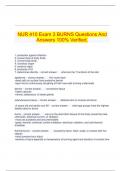NUR 410 Exam 3 BURNS Questions And
Answers 100% Verified.
1. protection against infection
2. prevent loss of body fluids
3. control body temp
4. excretory organ
5. sensory organ
6. produces vit D
7. determines identity - correct answer. what are the 7 functions of the skin
epidermis - correct answer. -thin outer layer
-dead cells on surface from protective barrier
-layer that is continuously sloughing off with new cells forming underneath
dermis - correct answer. -connective tissue
-highly vascular
-nerves, sebaceous, & sweat glands
subcutaneous tissue - correct answer. attaches skin to muscle and bone
<4 years old and adults over 65 - correct answer. what age groups have the highest
fatality rates for burns
burns - correct answer. -injury to the skin/other tissues of the body caused by heat,
chemicals, electrical current, or radiation
-most are accidents and are preventable
-types: thermal, chemical, smoke inhalation, electrical, radiation, and cold thermal
(frostbite)
thermal burns - correct answer. -caused by flame, flash, scald, or contact with hot
objects
-most common burn injury
-severity of injury depends on temperature of burning agent and duration of contact time
,hydrochloric acid burn - correct answer. -chemical burn
-from tile, toilet, or pool cleaners
hydrofluoric acid burn - correct answer. -chemical burn
-from metal cleaners, rust removers
oxalic acid burn - correct answer. -chemical burn
-from paint, varnish, or tarnish removers
alkali burns - correct answer. -chemical burn
-from cement, oven/drain/heavy metal cleaners
-harder to manage due to protein hydrolysis-deeper penetration of skin, and melting
phenols - correct answer. -chemical burn from an organic compound
-includes disinfectant and petroleum products
smoke inhalation injury - correct answer. -from breathing noxious chemicals or hot
air causing damage to respiratory tract
-major predictor in burn victim mortality
-rapid initial/ongoing assessment is critical to watch for airway compromise and
pulmonary edema
-types: upper airway, lower airway, metabolic asphyxiation
-can be from direct contact with a fire or no direct contact
upper airway injury - correct answer. -injury from smoke inhalation
-injury to most, oropharynx, and/or larynx
-thermal burns
-inhalation of hot air, steam, or smoke
-mucosal burns of oropharynx and larynx manifested by redness, blistering, and edema
-assess where they were at and how long they were exposed
-have them open their mouth and take a look
swelling with rapid onset - correct answer. what regarding an upper airway injury is
an emergency?
eschar and edema (fill in blank) - correct answer. -what two things may compromise
breathing in an upper airway injury?
-facial and neck burns can be lethal
-internal pressure from ______ may narrow airway
lower airway injury - correct answer. -injury to trachea, bronchioles, and alveoli
-tissue damage related to duration of fume/smoke exposure
-pulmonary edema may not appear until 12 to 48 hours after burn (may manifest as
ARDS)
-may look stable, but want to observe patient for couple of days
, lower airway - correct answer. indicators of a ________ _________ injury:
-facial burns
-singed nasal hair
-hoarseness
-painful swallowing
-darkened oral and nasal membranes
-carbonaceous sputum
-being burned in enclosed space
-clothing burns around neck and chest
-wearing polyester or acrylic clothing which can melt and attach to skin
metabolic asphyxiation - correct answer. -smoke inhalation injury
-CO and hydrogen cyanide inhaled
-impairs O2 delivery to tissues, resulting in hypoxia and elevated carboxyhemoglobin
-can occur in absence of burn injury
carboxyhemoglobin - correct answer. -hgb combined with carbon monoxide
-death when levels are >20%
-impairs O2 delivery to tissues
-100% NRB 15 L/min to replace CO with O2
electrical burns - correct answer. -results from intense heat generated from an
electric current
-may result in direct damage to nerves and vessels, causing tissue anoxia and death
-severity of injury depends on amount of voltage, tissue resistance, current pathways,
surface area in contact with current, and length of time current flow was sustained
-bones and fat have more resistance compared to nerves and blood vessels to
electricity
-most damage occurs below skin
-can cause muscle spasms strong enough to fracture long bones and vertebrae
-will see multiple exit and entrance wounds bc electricity always trying to get to ground
dysrhythmias, cardiac arrest, severe metabolic acidosis, and myoglobinuria - correct
answer. what 4 things is a patient with electrical burns at risk for?
myoglobinuria - correct answer. due to massive muscle and blood vessel damage,
the pt can have myoglobin from muscles and hgb from damaged RBC travel to the
kidneys which can lead to a cute tubular necrosis and AKI
severity - correct answer. _________ of injury determinants
-depth of burn
-extent of burn (% of TBSA)
-location of burn
-age of patient, pre-burn medical history, and circumstances or complicating factors




